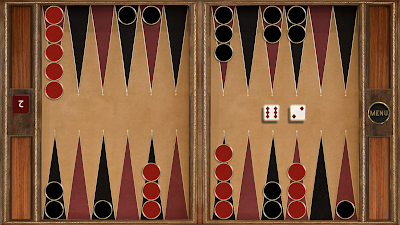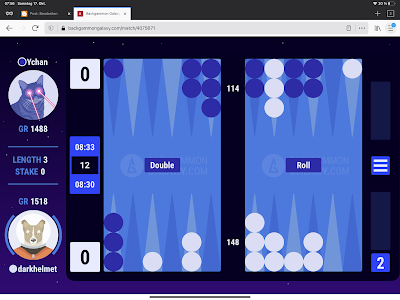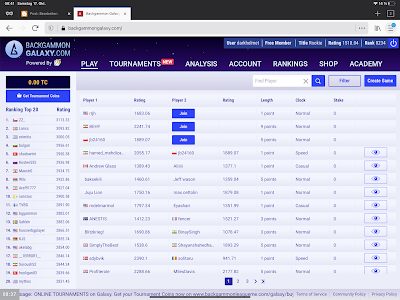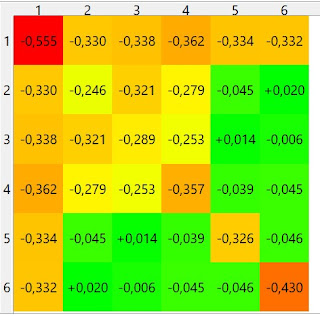Not as old as the real pioneers of computer backgammon, but old enough, there since 2002, and still being developed and performing on top level: the strong backgammon program BGBlitz. For iOS, there are two apps utilizing the BGBlitz engine, and while I wasn't entirely convinced of Backgammon Gold, the second app, True Backgammon HD, shines on iOS, and is a worthy contender for the Backgammon crown on Apple's platform.
True Backgammon's leather board (iPhone)
Visually, and acoustically, TBHD is my most favorite Backgammon for iOS. The leather board above costs €1 in-app, but that's worth it. By default there's a nice wooden board and a just as nice metal board for you to choose. And while the clicking and dice-rolling sounds of nearly every other backgammon sound cheap and cheesy, the ones of TBHD are so enjoyable that I'm actually playing most games with sound on.
The free metal board. Notice how the triangle shape of the pips shines through the semi-transparent checkers? Nice!
The drawback of this clean, simple, beautiful design is that actually playing is a bit annoying. Want to know who leads in the race? Tap on menu to have the board scroll sidewards and reveal this info. Want to try out different moves (which is absolutely normal in Backgammon, even on professional level)? Tap the menu, wait for the board to scroll to the side, tap undo (you can also just move the pieces back to their previous location, like on a normal board, though).
Another minor annoyance is the way the game supposedly beautifully scrolls up a bit when offering a double:
The wooden board, I'm being offered a double
Doubling is a critical, complicated part of Backgammon that requires full concentration. Frankly, it's beyond me why I can't see the full, normal board but only see the top half of the upper row. This might be considered a minor issue, but it's annoying as hell (particularly as my cube handling is vastly inferior to my dice handling, so I really need to concentrate there).
Moving the checkers on a tablet is a wonderful matter. You grab a checker and move it to its destination with a well-done drag-and-drop implementation. You can even drag-and-drop back and forth when trying out different moves, like on a real board) and multi-drag several checkers. By now, TGBG supports different ways to move, on devices of all sizes. I like drag&drop most because it feels nearly like a real board.
Yes, these are no major issues, but TBHD costs somewhere between €4 and €15 depending on your in-app spending habits. You need at least the basic game (€3.50) and the BGBlitz AI features (€6). At this price of admission I expect a rather flawless app.
For a Tron-ish Backgammon experience download a neon board (in-app purchase €1). Here I'm being offered a hint by the tutor.
If you purchase the BGBlitz tutor for about €3 (in-app), and you should, because an AI that destroys you without telling you where you're failing is a frustrating experience, then TGHD will give you the usual insights into your errors and blunders. This is nicely done, shows everything you get out of the other top-notch mobile AIs.
This is what it looks like: it tells you the preferred move + all the equities and probabilities that backgammon fans need to understand the evaluation. Also the game shows you visually on the board what the best move would have been. Same for doubling. And with BGBlitz being fairly strong, these hints can help a lot to tune your mental pattern matching abilities.
As we're at it: how strong is the app, exactly? I analyzed quite a few games with XG2 on the PC (roller++); result is that it plays about as good as the best humans on their very good days. It performs at a PR rating of about 1.5 to 2.5. Similar to BG NJ, slightly inferior to XG Mobile's super-human strength of about 0.5 PR. But honestly: you'll never notice. BGBlitz in this app makes no errors that are worth mentioning, and it will teach you to avoid your errors just as well as XG Mobile.
Just to be sure you take this with the right grain of salt: A low PR means better. World-class players manage to get a PR below 4. The currently strongest human player has a PR of 2.4. TBHD has a PR of somewhere around 1.8. It plays significantly stronger than any human can play.
It's a difference if you don't invest the money for the BGBlitz in-app purchase. XG rates me as an "advanced" player with a PR of about 11, and I'm soundly beating TBHD's free built-in AI on its hardest level. For newbies the AI is sufficient but don't expect to learn anything, improve your backgammon, or maybe get your mind blown by a state-of-the art AI destroying you over and over and showing you that luck plays a much lower role in Backgammon than you thought.
The (also) beautiful oriental board, scrolled to the left to make place for the menu.
For the sake of completeness: the app offers two-player "share a device" gaming and network gaming. I havent' tried out both. The app comes with pretty much all rules, but I haven't found Jacoby/Beaver. You can play money games or tournaments of every normal tournament length.
Double-clicking on the match score will open a "export and mail match as sgf". However often XG2 and/or gnu bg can't import the sgf due to some errors in the file. Hoping for a fix.
My summary: this is a great backgammon. With some small tweaks (maybe an "undo" / "show pip" gesture; single-click move on iPhone, different way to show "double?" dialog) it would be the best of the best. As it is, it's the backgammon of choice if you want the most beautiful top-notch backgammon on an iPad. If you want to play not only a world champ but a superhuman AI, go for XG mobile. If you like post-mortem analysis on the device, go for BGNJ.
Update: in the last months, TBHD has received a couple of great new features that catch up with XG Mobile. I particularly like the new game / match statistics (German here, unfortunately) that show you precisely how well you were doing in the current game and match, and whether the dice gods were looking down on you approvingly or punishing you with bad luck :-)
As a result, I‘m playing nearly all my “bot matches” with TBHD; the beautiful board, the nice drag and drop, the strong engine, and the insights in a single package are better than the competition.
Disclaimer: I’m not affiliated with the developer of TBHD, but after my first review he contacted me, took my suggestions seriously, implemented them, and I acted as a tester for them. So I might be more enthusiastic about the app than if I were completely neutral. I consider this just an additional feature: the developer cares and listens. (I’ve got different reactions to feedback I gave to other apps…)








































